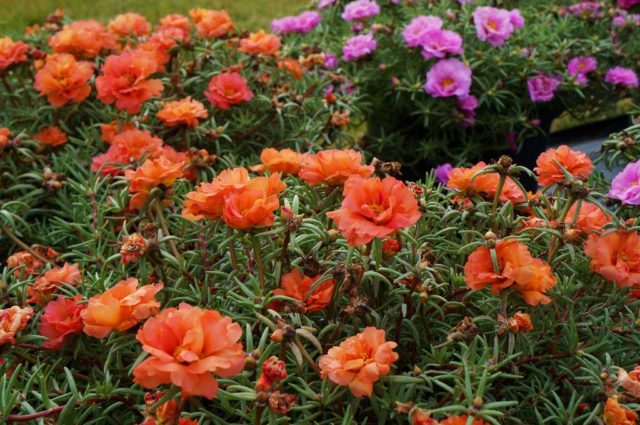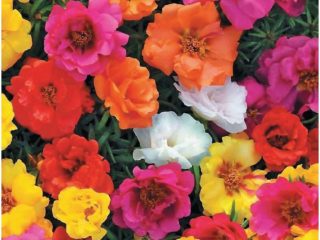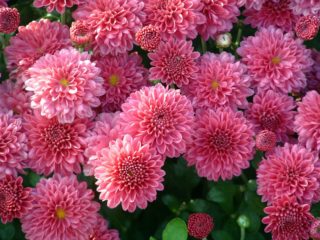Content
Planting and caring for purslane is universal, since the crop does not have complex agricultural techniques: it does not require watering, pruning, and is not exposed to diseases and pests. The plant is a magnificent decoration of the garden, thanks to its harmonious appearance: bright and rich colors of satin inflorescences, exquisite needle-like leaves. The decorative “mat”, or “dandur”, quickly grows over the surface, so the plant is planted in mixborders, flower beds, forming borders, alpine slides, decorating containers, hanging pots. In its natural habitat, purslane grows in the mountainous regions of the American continent, the North Caucasus, and Altai.Translated from Latin, “portula” sounds like “small gate,” which is due to the peculiarities of the opening of the seed pods. Ripe seed pods open like little gates.
Description of the purslane flower
Terry purslane is planted as a ground cover plant. The culture belongs to the Portulakov family. The popular annual succulent has the following characteristics:
- plant size from 20 cm to 30 cm;
- the root system is powerful, fan-shaped;
- stems are fleshy, juicy, hollow inside, creeping;
- stem color red-brown;
- leaf blades are flat, fleshy, ovoid;
- leaf color is light green;
- the bud is cup-shaped, peony-shaped, rose-shaped, consists of several rounded petals arranged in several rows;
- the buds are arranged singly on the stems;
- bud diameter up to 7 cm;
- the color of the buds is various shades of yellow, red, orange, purple, violet, pink, cream, white.
A unique feature of double dandur is the fact that the flowering of one inflorescence lasts throughout the day. By evening it fades, but against the general background it seems that the budding of the lush “living carpet” does not stop.
The crop is resistant to trampling, unpretentious to soil composition and maintenance.

Continuous flowering of double dandur lasts from July to September
Types and varieties of purslane
Known varieties of purslane are divided into two main types:
- Decorativee - these are cultivated, large-flowered, double crops, which are characterized by the presence of many varieties, a riot of colors and shades.
- Vegetable garden are edible plants whose foliage is used for medicinal and culinary purposes.
Planting and caring for terry purslane is easy.Numerous varieties are grown for decorative purposes.
Air marshmallow
Air marshmallow is a snow-white terry variety with delicate, beautiful flowers. The bushes grow quickly and fill the space with numerous cobwebs of needle-like foliage.

The white color of Puffed Marshmallow harmonizes perfectly with other crops in the garden
Cream
Cream is a unique hybrid variety with buds painted in a soft beige color. A special feature of the flowers is the cream color of the petals, which are slightly darker near the central part of the inflorescences.

Small buds of Purslane Cream can reach a diameter of up to 5 cm
Splendence
Splendence is an exquisite terry variety with bright pink petals. Large pink buds look elegant against a bright green carpet of stems and foliage.

Purslane Splendence is full of bright pink spots in the flowerbed
Tequila White
Tequila White is a famous snow-white variety. An ornamental plant can quickly weave an area with a lush web of foliage.

Small white buds of purslane Tequila White at the height of summer cover the flower garden with a continuous snow carpet
Flamenco
Flamenco is a low-growing (up to 15 cm in height) variety. Fleshy, strong shoots with needle-colored foliage are harmoniously combined with large, showy double-type flowers, which are characterized by a wide range of bud colors.

Multi-colored buds of the Flamenco variety decorate the flowerbed for several months
Cherry
Cherry is a medium-growing ornamental variety. It is characterized by fleshy, powerful, creeping shoots of bright green color, against the background of which large double inflorescences of a juicy cherry shade bloom daily.

The diameter of cherry blossoms of the Cherry variety reaches 5 cm
Scarlet
Scarlet is a popular variety with double buds of bright red and scarlet flowers. The size of the buds of the variety is medium. In one bed you can combine Scarlet bushes with other brightly flowering varieties.

Purslane variety Scarlet blooms during the summer until mid-autumn
Sanglo
Sanglo (Sunglo) is an ornamental variety characterized by original buds of a soft pink color. Against the background of soft green needle-like foliage, graceful pink flowers look original.

The Sanglo purslane variety is characterized by a special structure of buds that do not close even when it rains
Sonya
Sonya is a current garden variety that has a wide color palette. The buds are characterized by a variety of colors of satin petals: from white, pink and yellow to purple, burgundy and scarlet.

Purslane petals of the Sonya variety have the most delicate satin texture, with beautiful tints
Pun
Kalambur is a miniature variety up to 15 cm high. The rose-shaped buds are distinguished by their large sizes, juicy, bright shades of rounded terry petals.

The purslane variety Kalambur is a universal variety, most in demand among landscape designers, valued for its remarkable ground cover properties of large stems and bright flowering buds
Purslane in landscape design
Among landscape designers, growing purslane in open ground is especially popular. A low-growing, ground cover plant with bright small flowers - a universal decoration of the local area as an independent decor:
- free space between individual elements of garden paths;
- border between individual paths, beds, flower beds;
- stones, rockeries, alpine slides.

An unpretentious “mat” feels great between the individual elements of the pedestrian path

Elegant compositions featuring terry dandur in decorative pots - independent elements of landscape design
Decorative purslane is indispensable for single plantings, as well as for harmonious combinations with other garden plants:
- decorative cereals, herbs;
- petunias, snapdragons, lilies, roses, phlox;
- perennial hosts;
- spring bulbous plants (tulip, daffodil).

Terry dandur looks elegant and harmonious in the foreground of mixborders

An ornamental ground cover plant with multi-colored buds goes well with the rich palette of snapdragons and petunias.
Peculiarities of purslane propagation
To grow purslane, you should know the basic methods of propagating ornamental crops:
- seed (growing seedlings, sowing in open ground, self-seeding);
- vegetative (cuttings).
The seed propagation method is the simplest and most accessible. Seeds are sown immediately in open ground in April or May, or seedlings are grown indoors in early March. Plants can reproduce by self-sowing, with flowering occurring in the next growing season.

Dandur seeds remain viable for 2-3 years
For vegetative propagation, the mother bush is dug out of the ground in late autumn and stored in a warm room until spring. In March, cuttings are cut (shoots from 5 cm in size). The leaves are completely removed from the lower part of the shoots, and the cuttings are buried in the soil.

Cuttings are used primarily to preserve varietal characteristics
Planting and caring for purslane in open ground
Purslane is sown in open ground in the spring - this is one of the simplest and most accessible methods of growing this plant. Seed material can be purchased in specialized stores or collected at home.

The decorative “mat” is not distinguished by complex agricultural technology
When can you plant purslane?
In conditions of early and warm spring (southern regions with a mild climate), you can sow purslane flowers in open ground in early April or early May (for the central and northern regions of Russia).
For seedlings, seeds are sown in containers in March-April. You can close them in February-March, but in this case the sprouts will need additional lighting. A soil mixture of equal parts of turf soil and sand is placed in a disinfected container.

When sowing terry dandur seeds for seedlings, humus or compost cannot be used as a soil mixture.
On what soil does purslane grow?
The optimal place for placing terry purslane is open, sunny, dry and warm places, hills on the south side. The lack of natural sunlight reduces the duration and splendor of flowering. The plant is a heat-loving crop, therefore it does not grow at temperatures below + 10 ⁰С.
Decorative purslane does not tolerate stagnant water, so the “place of residence” of the crop should not contain close groundwater.
There are no requirements regarding the composition of the soil for the plant. Even the most depleted, sandy, poor soil is suitable for garden purslane. In soil fertilized with mineral preparations, the crop will gain mass in the foliage and stems, while the processes of budding and flowering will be slowed down.

To weather conditions (slight cooling, cloudy skies, rain), the “mat” reacts by closing the buds
How to plant purslane seedlings
Terry purslane seedlings are transferred to beds and flower beds when a consistently warm air and soil temperature is established at least + 10 ⁰C. The seedlings, hardened for a week, are planted in open ground at the end of May or early July. By this time, young bushes have up to 15 leaves and 2-3 buds. The sprouts are carefully buried in the soil up to the first leaf, following a planting pattern of 15x15 cm.

When the thermometer drops below +10 ⁰C, sensitive leaves on young bushes of the decorative “rug” may fall off
How to sow purslane directly into the ground
One of the ways to propagate terry purslane is to sow seeds directly into open ground. Before sowing, the bed is moistened abundantly. Since the seed material is small in size, garden purslane seeds are mixed with a small amount of soil or sand and are not buried in the ground. The mixture is carefully and evenly distributed on the surface of the soil, sprinkled with sand, and watered. Watering ensures natural deepening of the seed. Since in April-May there is a possibility of the air temperature dropping below + 25 C, the crops are covered with plastic film. After the temperature has stabilized, the shelter is removed.

5-7 weeks after sowing terry purslane seeds in open ground, long and abundant flowering of the ground cover plant begins
Growing and caring for purslane
Growing and caring for decorative purslane does not involve complex agricultural technology. The culture is unpretentious in care, practically does not require watering and fertilizing, and does not need shelter for the winter.Planting and caring for perennial purslane in Russia is practiced as for classic annuals, since the culture does not survive in the harsh conditions of the European winter.

Decorative purslane is an unpretentious, beautiful, original ground cover plant that requires minimal care
Watering and fertilizing schedule
During dry, rainless summers, it is recommended to water the flowering “mats” of decorative purslane varieties once a week.
The stems and foliage of the plant tightly cover the soil around the bushes, forming a kind of mulch. Therefore, the crop does not need any loosening or mulching at all.

There is no need to fertilize or feed terry purslane bushes; the plants grow well in any soil
Wintering
Decorative purslane is grown as an annual plant in the Russian Federation. Only the garden variety is prepared for wintering. However, small bushes of garden flowering purslane can be transplanted into indoor pots, flowerpots or containers so that the plant continues to bloom in winter.

Terry dandur, transplanted into indoor pots, feels good on windows facing south
Pests and diseases
Decorative purslane is practically not exposed to pests and diseases. Sometimes the plant becomes infected with the pathogen Albugo Portulaceae. The affected leaves become covered with spots, creases and deformations appear on the shoots. Diseased parts of the plant are removed, and the bushes are treated with modern fungicides.

If signs of a fungal disease Albugo Portulaceae are detected, terry dandur is sprayed with preparations containing copper
Aphids are sucking pests that can cause damage to purslane mats.In case of damage to the bushes, you can spray with Actellik.

To completely get rid of aphids, insecticide treatment is repeated after one week.
Why purslane does not bloom, what to do
Decorative terry purslane is a unique representative of the world of flora, which feels most comfortable only in spartan conditions: where other plants die of thirst, burn in the sun and suffer from depleted soil.
For abundant, endless and longest flowering for purslane, the following rules must be followed:
- a lot of sunlight (does not bloom even with slight shading);
- fairly stable warm weather without sudden cold snaps (closes the buds from lowering air temperatures);
- minimum water (it is a dry-loving plant);
- sandy, rocky, unfertilized soil (when adding organic matter, the plant will direct its main forces to the growth and development of stems and foliage).

By placing garden dandur in the full sun, on dry and lifeless soil, you can achieve stunning flowering of satin double inflorescences
Conclusion
Since planting and caring for purslane is characterized by simple and affordable agricultural technology, many Russian gardeners choose this ornamental crop to decorate their home area. Since the time of Hippocrates, people have used the healing properties of this plant. Seeds, leaves and stems of dandur healed snake bites and cleansed the body of waste and toxins.








